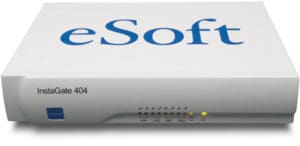Estimated Reading Time: 6 minutes
It’s the month you’ve been waiting for… October is officially National Cybersecurity Awareness Month (since 2004)—which means you should clear your schedule, take stock of your digital defenses, and prepare the worst. Yes, cancel those weekend dinner plans with your in-laws. Ignore the yard—it can go another week without mowing. This weekend you’ll want go through your home systematically unplugging all of those smart switches, smart assistants, smart light bulbs, and smart…
OK. Maybe that’s going a little too far. But we still recommend taking stock of your devices, check the security settings on your network devices, and updating any of your “standard” passwords to something more secure than ‘password’ or ‘1234’.
A Look Back at the Original IPAD
This year for National Cybersecurity Awareness Month, we thought we’d take a look back at the original IPAD. No, not the popular tablet from Apple awaiting a design refresh—and leaving tech enthusiasts crawling through rumor sites. No, we’re referring to the Internet Protocol Adapter (IPAD)—the next-generation all-in-one security and gateway device for accessing Bulletin Board Systems and online services from the 1990’s.
Just for context, let’s take a quick look at the early world of networking and the internet…
In the Beginning, There was BBS
In the late 70’s and early 80’s, the internet landscape as we know it today was just coming together. The popular computers of the time were the Apple II (1977), Commodore PET (1977), TRS-80 (1977), IBM PC (1981), and the Commodore 64 (1982). But the envisioning of the World Wide Web as we know it was still more than a decade away—and computer networking looked very different. Since the late 70’s, networking was primarily achieved through Bulletin Board Systems (or BBS). A BBS was effectively a computer server that connected to other BBS’s and to services such as FidoNet (think early email) using another new piece of hardware—a modem.
 In 1983, Phil L. Becker—a former rocket scientist—was taking strides towards commercializing internet access via an improved BBS. He wrote a multiline MS-DOS based commercial bulletin board software package—based on the earlier CBBS (Computerized Bulletin Board System) computer program created by Ward Christensen and Randy Suess. It was named The Bread Board System, or TBBS, and was intended to provide a better and more customizable experience for BBS administrators and computer enthusiasts everywhere. Based on strong sales and interest early on, Becker founded eSoft, Inc. in 1984.
In 1983, Phil L. Becker—a former rocket scientist—was taking strides towards commercializing internet access via an improved BBS. He wrote a multiline MS-DOS based commercial bulletin board software package—based on the earlier CBBS (Computerized Bulletin Board System) computer program created by Ward Christensen and Randy Suess. It was named The Bread Board System, or TBBS, and was intended to provide a better and more customizable experience for BBS administrators and computer enthusiasts everywhere. Based on strong sales and interest early on, Becker founded eSoft, Inc. in 1984.
For much of the next decade, TBBS helped connect millions of users worldwide and shape the direction of the modern internet. Modems and other equipment became more cost-effective with technology advancements and increased popularity for personal computers. New releases like Apple’s Macintosh computer in 1984 and the first Windows operating system, Windows 1.0, in 1985 made computer access possible for countless new academics, businesses, and hobbyists alike. In 1988 Becker and eSoft added a custom multitasking kernel that allowed multiple callers to access a TBBS system simultaneously—cementing their market advantage over all other bulletin board systems.
The Internet Protocol Adaptor (IPAD): A Breakthrough Gateway & Security Device
Then, in the early 90’s, Becker and eSoft saw the shift towards the modern internet—where instead of connecting to a single system or BBS, users would connect to a network and gain access to many systems and online services. In 1993 Becker began work on an Internet Protocol Adaptor (IPAD). The first models, the eSoft IPAD 1200 and 2500 were released in 1995.

Primary development of the IPAD occurred between 1995 and 1997. It was designed as an all-in-one computer server—providing all the necessary hardware and software components necessary to achieve bidirectional access to TBBS via telnet. Additionally, it included other services such as RAS, DNS, FTP, and more—allowing owners to use the IPAD as an internet gateway, in addition to the TBBS access features. In total, there were three IPAD models, the IPAD 1200, IPAD 2500, and IPAD 5000—all of which ran IPAD-OS.
IPAD-OS: Built for Security
At this point, Becker and eSoft had nearly 10 years of experience building and managing TBBS code and networking solutions for the early internet. For the IPAD, they understood the importance and need for a robust and secure operating system—designed for specifically for networking. Enter IPAD-OS, an operating system designed for the modern internet.
It was deemed “bullet proof” with “virtually no way to be infected with a virus”. At the kernel level, it focused on providing networking capabilities and security with locked down administrator access and firewall settings. IPAD owners and TBBS operators at the time praised IPAD-OS for speed, security, and low maintenance.
The Fall of BBS and the IPAD
For a short period, the IPAD was extremely popular among commercial TBBS operators—delivering a single appliance that granted TBBS and internet access in the early days of the modern internet. But as Becker and eSoft saw the coming of a new internet, they invested more effort into evolving the networking capabilities of the IPAD—shifting away from TBBS features and support. Though Becker’s intuition and direction was correct, this move ruffled feathers among the TBBS System Operators (Sysops) and the BBS community.
The IPAD was one of the first all-in-one networking devices of its kind. Helping to usher in a new era of internet connectivity, the IPAD delivered a powerful combination of hardware, software, and security. Due to the rapidly changing internet landscape—development of the IPAD slowed in 1997 and in-house support was eventually halted in 1999. Ongoing support for existing IPAD users continued from the IPAD Owners Association, Inc (IOA). You can learn more about IOA on their website at www.ipadowners.org.
Another reason for the IPAD’s retirement was price. The cost of the IPAD put it out of reach of many TBBS hobbyists that had already invested thousands of dollars into hardware that they used to provide free networking systems for friends, clubs, and groups of enthusiasts. This, combined with the envisioning of the World Wide Web and other reasons, spelled the eventual end for the IPAD.
At its peak in 1996, the IPAD and TBBS was the most efficient high-speed and cost effective multi-user networking system available. Software companies like Microsoft and many of the largest computer hardware companies relied solely on TBBS to provide technical support and file downloads to their customer bases.
The Internet in the 2000’s, SiteFilter, and Beyond
 Though the IPAD’s reign was brief, it served as a precursor to eSoft’s other technologies and services of the late 90’s and early 2000’s. In 1999 eSoft acquired Apexx Technology and Technologic—pairing the technology and security offerings for the development of the InstaGate, one of the first and highly rated Unified Threat Management (UTM) appliances.
Though the IPAD’s reign was brief, it served as a precursor to eSoft’s other technologies and services of the late 90’s and early 2000’s. In 1999 eSoft acquired Apexx Technology and Technologic—pairing the technology and security offerings for the development of the InstaGate, one of the first and highly rated Unified Threat Management (UTM) appliances.
eSoft continued to innovate, adopting a software subscription model in addition to their appliance business, with SaaS offerings for antivirus, antispam, web filtering, IPS and more. By the 2008-09 timeframe, eSoft was developing the industry’s most advanced content categorization and malicious website detection technologies—allowing for categorization of URLs at the individual page level.
These web filtering efforts led to increased sales and focus on software-based services, eventually resulting in the company’s decision in 2010 to spin-off the InstaGate UTM product line. The company rebranded under the zvelo name and focused on a subscription model, licensing the zveloDB URL database and categorization services to OEM partners.
And our mission of Categorizing the Web was underway!
If you’d like to read more about the history and beginnings of zvelo—visit our Company History page.
Thanks for reading and helping make the internet a safer and more secure place for all!





